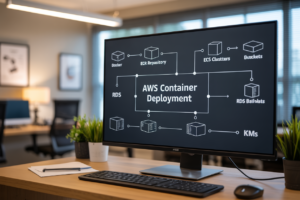Ever spent hours building a data model only to watch it crumble under growing data volumes? You’re not alone. Nearly 70% of analytics projects fail because their data models can’t scale with business needs.
Building scalable data architecture in Snowflake isn’t just about technical know-how—it’s about strategic thinking that anticipates tomorrow’s analytics questions while solving today’s problems.
This guide will show you data modeling in Snowflake that won’t collapse when your data doubles or your user base triples. We’ll cover proven patterns that major enterprises use to handle petabytes without performance degradation.
The difference between a good data model and a great one? About six months of refactoring work you could avoid with the right approach upfront.
Want to know the modeling mistake that even experienced data engineers make on day one?
Understanding Snowflake’s Data Architecture
Key Components of Snowflake’s Multi-Cluster Architecture
Snowflake isn’t your typical data warehouse. It’s built on three distinct layers that actually make sense: storage (where your data lives), compute (virtual warehouses that do the heavy lifting), and services (the brains coordinating everything). This separation is pure genius – your storage can grow without affecting performance, and multiple teams can work without stepping on each other’s toes.
How Separation of Storage and Compute Benefits Analytics
Data teams dream about this setup. Need to run a massive report? Spin up a bigger warehouse. Only doing light queries? Scale down and save money. The beauty here is flexibility – your storage costs stay constant while you only pay for compute when you need it. No more overprovisioning “just in case” or watching expensive resources sit idle.
Virtual Warehouses and Their Role in Performance
Virtual warehouses are Snowflake’s secret weapon. Think of them as dedicated compute clusters you can assign to different workloads. Marketing needs to run daily dashboards? Give them their own warehouse. Data scientists crunching numbers? They get their own too. No resource conflicts, no finger-pointing, just happy teams getting their work done.
Fundamental Data Modeling Approaches for Snowflake
A. Star Schema vs. Snowflake Schema: Choosing the Right Approach
Star schemas simplify analytics with direct joins between fact and dimension tables, while snowflake schemas normalize dimensions for storage efficiency. For Snowflake, stars typically deliver better query performance since the platform’s columnar storage already optimizes space. Choose based on your priority: faster queries or strict normalization.
Optimizing Table Structures for Analytics Performance
Optimizing Table Structures for Analytics Performance
A. Clustering Keys: Selection and Implementation
Want to turbocharge your Snowflake queries? Clustering keys are your secret weapon. Pick columns your users filter on most—date ranges, customer IDs, regions. Don’t go overboard though. Three columns max usually does the trick, and ordering matters. Put high-cardinality columns first for best results.
Advanced Data Modeling Patterns
Data Vault Implementation in Snowflake
Data Vault modeling in Snowflake rocks for scalability. The hub-link-satellite approach perfectly matches Snowflake’s MPP architecture. Want flexibility with massive datasets? This pattern shines by separating business keys (hubs) from relationships (links) and descriptive data (satellites). No more rigid schemas holding you back when requirements shift mid-project.
Integration with Modern Data Pipelines
Integration with Modern Data Pipelines
A. ELT vs. ETL in the Snowflake Ecosystem
The game has changed. ETL (Extract, Transform, Load) used to rule data pipelines, but Snowflake thrives on ELT (Extract, Load, Transform). Load your raw data first, then transform it using Snowflake’s compute power. This approach gives you more flexibility and lets your data engineers focus on what matters – delivering insights faster.
B. Designing for Automated Data Loading
Modern data pipelines need automation. Build your Snowflake models with automated loading in mind by creating staging tables that can handle various data formats. Set up file detection patterns in your external stages and create procedures that trigger automatically when new files arrive. This cuts manual work and keeps your data fresh.
C. Managing Dependencies Between Data Models
Dependencies can make or break your data pipeline. Create a clear hierarchy for your models using Snowflake tasks and streams to track changes. Document which models rely on others and establish proper refresh sequences. When upstream models change, your downstream analytics won’t break, keeping business users happy and reports reliable.
Governance and Security in Data Modeling
Governance and Security in Data Modeling
A. Row-Level Security Implementation
Securing your Snowflake data at the row level isn’t just a nice-to-have—it’s essential. Think about it: your marketing team shouldn’t see sales compensation data, right? Implementing row-level security through secure views and row access policies lets you enforce these boundaries naturally within your data model, not as an afterthought.
B. Dynamic Data Masking Strategies
Ever shown someone your credit card but covered most numbers except the last four? That’s essentially what dynamic data masking does in Snowflake. You keep sensitive data (like SSNs or emails) visible to those who need it while showing masked versions to everyone else. No duplicate tables needed—just apply masking policies directly to your columns.
C. Implementing Column-Level Security
Column-level security works like those VIP areas at events—some people get access, others don’t. In Snowflake, you can restrict entire columns from certain roles while keeping them visible to authorized users. This granular approach means your finance team sees salary data that remains completely invisible to others querying the same table.
D. Role-Based Access Control Best Practices
Your Snowflake roles should mirror how your organization actually works. Skip the one-size-fits-all approach. Create functional roles (Finance_Analyst, Marketing_Admin) instead of generic ones. Then build hierarchies that reflect your org chart. Remember: effective RBAC isn’t just about restricting access—it’s about enabling people to do their jobs without data barriers.
Performance Tuning for Analytical Workloads
Query Optimization Techniques
Snowflake query performance can tank fast if you’re not careful. Start with proper filtering – push those WHERE clauses early in your queries. Use EXPLAIN to see what’s happening under the hood. Avoid SELECT * like the plague. Partition pruning is your best friend for large tables.
Materialized Views: When and How to Use Them
Effective data modeling in Snowflake requires a thoughtful approach that balances performance optimization with scalable architecture. By understanding Snowflake’s unique architecture, implementing appropriate modeling techniques, and optimizing table structures, organizations can build analytics environments that grow with their needs. Advanced patterns like hybrid models and proper integration with modern data pipelines further enhance these capabilities, while governance and security measures ensure data remains protected.
As you implement these strategies in your Snowflake environment, remember that performance tuning is an ongoing process. Start with the fundamental approaches outlined in this guide, regularly monitor your workloads, and be prepared to adapt your models as requirements evolve. With these data modeling practices in place, your organization will be well-positioned to unlock powerful, scalable analytics capabilities that drive business value and insights.




















